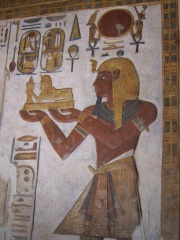
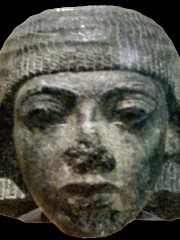
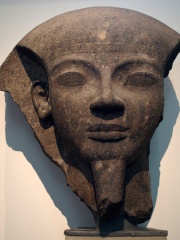
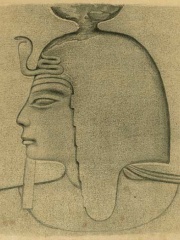
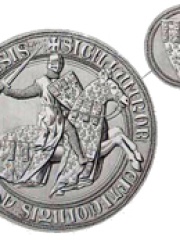
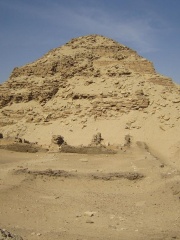

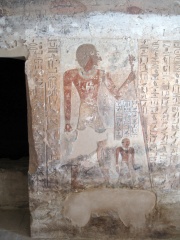
The Most Famous
NOBLEMEN from Egypt
Top 10
The following people are considered by Pantheon to be the top 10 most legendary Egyptian Noblemen of all time. This list of famous Egyptian Noblemen is sorted by HPI (Historical Popularity Index), a metric that aggregates information on a biography's online popularity. Visit the rankings page to view the entire list of Egyptian Noblemen.

1. Ramesses III (1217 BC - 1155 BC)
With an HPI of 77.73, Ramesses III is the most famous Egyptian Nobleman. His biography has been translated into 57 different languages on wikipedia.
Usermaatre Meryamun Ramesses III was the second Pharaoh of the Twentieth Dynasty in Ancient Egypt. Some scholars date his reign from 26 March 1186 to 15 April 1155 BC, and he is considered the last pharaoh of the New Kingdom to have wielded substantial power. His long reign saw the decline of Egyptian political and economic power, linked to a series of invasions and internal economic problems that also plagued pharaohs before him. This coincided with a decline in the cultural sphere of Ancient Egypt. However, his successful defense was able to slow down the decline, although it still meant that his successors would have a weaker military. He has also been described as a "warrior Pharaoh" due to his strong military strategies. He led the way by defeating the invaders known as "the Sea Peoples", who had caused destruction in other civilizations and empires. He was able to save Egypt from collapsing at the time when many other empires fell during the Late Bronze Age; however, the damage of the invasions took a toll on Egypt. Rameses III constructed one of the largest mortuary temples of western Thebes, now called Medinet Habu. He was assassinated in the Harem conspiracy led by his secondary wife Tiye and her eldest son Pentawere. This would ultimately cause a succession crisis which would further accelerate the decline of Ancient Egypt. He was succeeded by his son and designated successor Ramesses IV, although many of his other sons would rule later.

2. Ramesses I (1300 BC - 1290 BC)
With an HPI of 77.57, Ramesses I is the 2nd most famous Egyptian Nobleman. His biography has been translated into 54 different languages.
Menpehtyre Ramesses I (or Ramses) was the founding pharaoh of ancient Egypt's 19th Dynasty. The dates for his short reign are not completely known but the timeline of late 1292–1290 BC is frequently cited as well as 1295–1294 BC. While Ramesses I was the founder of the 19th Dynasty, his brief reign mainly serves to mark the transition between the reign of Horemheb, who had stabilized Egypt in the late 18th Dynasty, and the rule of the powerful pharaohs of his own dynasty, in particular his son Seti I, and grandson Ramesses II.

3. Ramesses VI (1175 BC - 1136 BC)
With an HPI of 72.51, Ramesses VI is the 3rd most famous Egyptian Nobleman. His biography has been translated into 43 different languages.
Ramesses VI Nebmaatre-Meryamun (sometimes written Ramses or Rameses, also known under his princely name of Amenherkhepshef C) was the fifth ruler of the Twentieth Dynasty of Egypt. He reigned for about eight years in the mid-to-late 12th century BC and was a son of Ramesses III and queen Iset Ta-Hemdjert. As a prince, he was known as Ramesses Amunherkhepeshef and held the titles of royal scribe and cavalry general. He was succeeded by his son, Ramesses VII Itamun, whom he had fathered with queen Nubkhesbed. After the death of the ruling pharaoh, Ramesses V, who was the son of Ramesses VI's older brother, Ramesses IV, Ramesses VI ascended the throne. In the first two years after his coronation, Ramesses VI stopped frequent raids by Libyan or Egyptian marauders in Upper Egypt and buried his predecessor in what is now an unknown tomb of the Theban necropolis. Ramesses VI usurped KV9, a tomb in the Valley of the Kings planned by and for Ramesses V, and had it enlarged and redecorated for himself. The craftsmen's huts near the entrance of KV9 covered up the entrance to Tutankhamun's tomb, saving it from a wave of tomb robberies that occurred within 20 years of Ramesses VI's death. Ramesses VI may have planned and made six more tombs in the Valley of the Queens, none which are known today. Egypt lost control of its last strongholds in Canaan around the time of Ramesses VI's reign. Though Egyptian occupation in Nubia continued, the loss of the Asiatic territories strained Egypt's weakening economy and increased prices. With construction projects increasingly hard to fund, Ramesses VI usurped the monuments of his forefathers by engraving his cartouches over theirs. Yet he boasted of having "[covered] all the land with great monuments in my name [...] built in honour of my fathers the gods". He was fond of cult statues of himself; more are known to portray him than any Twentieth-Dynasty king after Ramesses III. The Egyptologist Amin Amer characterises Ramesses VI as "a king who wished to pose as a great pharaoh in an age of unrest and decline". The pharaoh's power waned in Upper Egypt during Ramesses VI's rule. Though his daughter Iset was named God's Wife of Amun, the high-priest of Amun, Ramessesnakht, turned Thebes into Egypt's religious capital and a second center of power on par with Pi-Ramesses in Lower Egypt, where the pharaoh resided. In spite of these developments, there is no evidence that Ramessesnakht's dynasty worked against royal interests, which suggests that the Ramesside kings may have approved of these evolutions. Ramesses VI died in his forties, in his eighth or ninth year of rule. His mummy lay untouched in his tomb for fewer than 20 years before pillagers damaged it. The body was moved to KV35 during the reign of Pinedjem I, and was discovered in 1898 by Victor Loret. His mummy is currently kept in the National Museum of Egyptian Civilization.

4. Setnakhte (1300 BC - 1188 BC)
With an HPI of 70.70, Setnakhte is the 4th most famous Egyptian Nobleman. His biography has been translated into 37 different languages.
Userkhaure-setepenre Setnakhte (also called Setnakht or Sethnakht) was the first pharaoh (1189 BC–1186 BC) of the Twentieth Dynasty of the New Kingdom of Egypt and the father of Ramesses III.
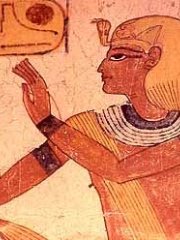
5. Ramesses IX (1150 BC - 1111 BC)
With an HPI of 69.44, Ramesses IX is the 5th most famous Egyptian Nobleman. His biography has been translated into 35 different languages.
Neferkare Setepenre Ramesses IX (also written Ramses) (originally named Amon-her-khepshef Khaemwaset) (ruled 1128-1110 BC) or 1129–1111 BC) was the eighth pharaoh of the Twentieth Dynasty of Egypt. He was the third longest serving king of this Dynasty after Ramesses III and Ramesses XI. He is now believed to have assumed the throne on I Akhet day 21 based on evidence presented by Jürgen von Beckerath in a 1984 GM article. According to the latest archaeological information, Ramesses IX died in Regnal Year 19 I Peret day 27 of his reign. Therefore, he enjoyed a reign of 18 years, 4 months and 6 days. His throne name, Neferkare Setepenre, means "Beautiful Is The Soul of Re, Chosen of Re." Ramesses IX is believed to be the son of Mentuherkhepeshef, a son of Ramesses III, since Mentuherkhopshef's wife, the lady Takhat bears the prominent title of King's Mother on the walls of tomb KV10, which she usurped and reused in the late 20th Dynasty; no other 20th Dynasty king is known to have had a mother with this name. Ramesses IX was, therefore, probably a grandson of Ramesses III.

6. Robert II, Count of Artois (1250 - 1302)
With an HPI of 66.11, Robert II, Count of Artois is the 6th most famous Egyptian Nobleman. His biography has been translated into 22 different languages.
Robert II (September 1250 – 11 July 1302) was the Count of Artois, the posthumous son and heir of Robert I and Matilda of Brabant. He was a nephew of two kings; Louis IX of France and Charles I of Sicily. A capable military commander and administrator, Robert was involved in a number of conflicts involving the French Capetian dynasty, including the War of the Sicilian Vespers and the Franco-Flemish War. He died during the latter conflict while leading a French army at the Battle of the Golden Spurs.

7. Neferirkare Kakai (2483 BC - 2480 BC)
With an HPI of 65.66, Neferirkare Kakai is the 7th most famous Egyptian Nobleman. His biography has been translated into 41 different languages.
Neferirkare Kakai (also known as Raneferirka Kakai and in Greek as Nefercherês, Νεφερχέρης) was an ancient Egyptian pharaoh, the third king of the Fifth Dynasty. Neferirkare, the eldest son of Sahure with his consort Meretnebty, was known as Ranefer A before he came to the throne. He acceded the day after his father's death and reigned for eight to eleven years, sometime in the early to mid-25th century BCE. He was himself very likely succeeded by his eldest son, born of his queen Khentkaus II, the prince Ranefer B who would take the throne as king Neferefre. Neferirkare fathered another pharaoh, Nyuserre Ini, who took the throne after Neferefre's short reign and the brief rule of the poorly known Shepseskare. Neferirkare was acknowledged by his contemporaries as a kind and benevolent ruler, intervening in favour of his courtiers after a mishap. His rule witnessed a growth in the number of administration and priesthood officials, who used their expanded wealth to build architecturally more sophisticated mastabas, where they recorded their biographies for the first time. Neferirkare was the last pharaoh to significantly modify the standard royal titulary, separating the nomen or birth name, from the prenomen or throne name. From his reign onwards, the former was written in a cartouche preceded by the "Son of Ra" epithet. His rule witnessed continuing trade relations with Nubia to the south and possibly with Byblos on the Levantine coast to the north. Neferirkare started a pyramid for himself in the royal necropolis of Abusir, called Ba-Neferirkare meaning "Neferirkare is a Ba". It was initially planned to be a step pyramid, a form which had not been employed since the days of the Third Dynasty circa 120 years earlier. This plan was modified to transform the monument into a true pyramid, the largest in Abusir, which was never completed owing to the death of the king. In addition, Neferirkare built a temple to the sun god Ra called Setibre, that is "Site of the heart of Ra". Ancient sources state that it was the largest one built during the Fifth Dynasty but as of the early 21st century it has not yet been located. After his death, Neferirkare benefited from a funerary cult taking place in his mortuary temple, which had been completed by his son Nyuserre Ini. This cult seems to have disappeared at the end of the Old Kingdom period, although it might have been revived during the Twelfth Dynasty of the Middle Kingdom, albeit in a very limited form. In all probability, it was also around this time that the story of the Papyrus Westcar was first written, a tale where Userkaf, Sahure and Neferirkare are said to be brothers, the sons of Ra with a woman Rededjet.

8. Dina bint Abdul-Hamid (1929 - 2019)
With an HPI of 64.15, Dina bint Abdul-Hamid is the 8th most famous Egyptian Nobleman. Her biography has been translated into 21 different languages.
Dina bint Abdul-Hamid (Arabic: دينا بنت عبد الحميد; 15 December 1929 – 21 August 2019) was a Hashemite princess and Queen of Jordan from 1955 until 1957 as the first wife of King Hussein. She was the mother to Hussein's oldest child, Princess Alia bint Hussein. She and the king were married from 1955 to 1957, and in 1970 she married a high-ranking official in the PLO. She was a graduate of the University of Cambridge and a lecturer in English literature at Cairo University.

9. Ahmose, son of Ebana (1600 BC - 1501 BC)
With an HPI of 63.41, Ahmose, son of Ebana is the 9th most famous Egyptian Nobleman. His biography has been translated into 18 different languages.
Ahmose, son of Ebana, (Amosis, Aahmes; meaning "Iah (the Moon) is born") served in the Egyptian military under the pharaohs Ahmose I, Amenhotep I, and Thutmose I. His autobiography, which is inscribed on the wall of his tomb, and remains remarkably intact, is a valuable source of information on the late 17th Dynasty and the early 18th Dynasty of Egypt. Ahmose was born in the city of Nekheb, the modern El Kab. During the war to expel the Hyksos from Egypt, in the reign of Seqenenre Tao, his father enlisted in the navy. After the deaths of Tao and his son Kamose, Ahmose began to serve as a soldier under Pharaoh Ahmose I. He participated in the battle of Avaris (the Hyksos capital in the Delta), where he killed two Hyksos and was awarded the "gold of valor" twice. Ahmose was awarded slaves and other spoils by the pharaoh after Avaris was sacked. Ahmose also participated in the three-year siege of Sharuhen in southern Canaan for which he was rewarded. He followed his king to Nubia, where they put down three rebellions. Under Amenhotep I, he fought against the Nubians and was given gold and slaves for his bravery. During the reign of Thutmose I, Ahmose participated in a naval campaign against Nubian tribes in the Nile valley and was appointed admiral. He also followed Thutmose on a campaign against Naharin all the way to the Euphrates River. Ebana was the name of Ahmose's mother, who was most likely a woman of importance on Egyptian society; his father's name was Baba. Paheri, the grandson of Ahmose and a scribe and priest of the goddess Nekhbet and tutor to the prince Wadjmose, supervised the building of his grandfather's tomb.

10. Princess Rym Ali (b. 1969)
With an HPI of 49.17, Princess Rym Ali is the 10th most famous Egyptian Nobleman. Her biography has been translated into 16 different languages.
Princess Rym Ali (née Rym Brahimi; born 1969) is the Algerian wife of Prince Ali bin Hussein of Jordan, whom she married on 7 September 2004. She is a former journalist.
People
Pantheon has 11 people classified as Egyptian noblemen born between 2483 BC and 1979. Of these 11, 2 (18.18%) of them are still alive today. The most famous living Egyptian noblemen include Princess Rym Ali, and Muhammad Ali, Prince of the Sa'id. The most famous deceased Egyptian noblemen include Ramesses III, Ramesses I, and Ramesses VI. As of April 2024, 2 new Egyptian noblemen have been added to Pantheon including Princess Rym Ali, and Muhammad Ali, Prince of the Sa'id.
Living Egyptian Noblemen
Go to all RankingsDeceased Egyptian Noblemen
Go to all RankingsRamesses III
1217 BC - 1155 BC
HPI: 77.73
Ramesses I
1300 BC - 1290 BC
HPI: 77.57
Ramesses VI
1175 BC - 1136 BC
HPI: 72.51
Setnakhte
1300 BC - 1188 BC
HPI: 70.70
Ramesses IX
1150 BC - 1111 BC
HPI: 69.44
Robert II, Count of Artois
1250 - 1302
HPI: 66.11
Neferirkare Kakai
2483 BC - 2480 BC
HPI: 65.66
Dina bint Abdul-Hamid
1929 - 2019
HPI: 64.15
Ahmose, son of Ebana
1600 BC - 1501 BC
HPI: 63.41


